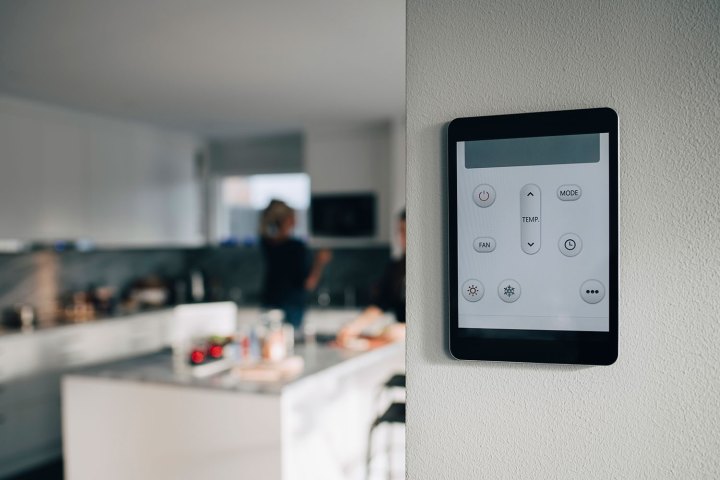
In today’s smart home, a weekday routine might have the alarm clock going off at 7 a.m., the shades raising, the thermostat turning up the heat a few degrees, and the lights turning on in the bathroom. But these scheduled tasks aren’t much help on a morning when you have to wake up an hour earlier to catch a flight, unless your hub has access to your calendar and is smart enough to trigger your wake-up sequence at 6 a.m. Here’s the question: Should your hub be able to ask you first?
One of the big questions with smart home technology is, “how much of this should be user-driven versus A.I.-driven?” said Mark Spates, Google’s product lead for smart home, during his keynote talk at the 2018 Connections Conference in San Francisco on May 22. And, in order to get to the level where devices start to act like the user without any input, the reliability has to be 100 percent, something that’s currently not happening, he said.
How much of the smart home should be user-driven versus A.I. driven?
The idea of sentient bots that seamlessly control every aspect of your life is hyperbole, iRobot’s Chris Jones said on a panel about artificial intelligence.
“That’s not something I’m worried about or I see being applicable to our products anytime soon,” Jones said. He called machine learning, A.I., and deep learning “very specific tools that are very good at some things but aren’t the solution to all problems.”
For the moment, device makers often use A.I. for mundane uses, like figuring out how often their products are offline.

“You’d be astonished at how abysmal the connectivity rates of IoT products are today,” said Aditya Pendyala, co-founder of Mnubo, which helps companies analyze their Internet of Things data. This is where A.I. could help figure out how to optimize software and setups to make more reliable products, he added.
“A lot of it we still don’t understand how it works or why it works on a fundamental level,” said Chris Mitchell, CEO of Audio Analytic.
A.I. still depends on humans – for better or worse
There are still humans behind the scenes, making decisions and fixing mistakes. The A.I. Is only as good as its input and the parameters people assign. For example, Mitchell’s company has a database of sounds that it uses to create profiles of glass breaking or dogs barking for smart devices, so they can recognize them when they happen in the real world and send the user an alert.
Sentient bots that seamlessly control every aspect of your life is hyperbole.
One company that uses the software noticed a large number of smoke alarms were going off in a certain part of France. Turns out that there weren’t actually fires; instead, a regional parrot’s squawk matched a manufacturer’s alarm sound closely enough that it was fooling the sensors.
Humans are fallible as well, and device makers can frame crucial parts of their systems around biases and outlooks that are far from universal.
“Americans are very tied to the idea of liberty, independence, and distrust of government. Many historical factors go into that idea of protecting one’s data,” Intel’s Melissa Gregg told Digital Trends. “We have to be careful as engineers and architects building this technology that we don’t presume that our point of view on privacy is going to hold to everyone.”

While the machines aren’t ready, Gregg thinks we’re not really equipped, either. “We still don’t have a very good attitude or even psychological preparedness for when a machine has agency,” she said, though she admits there are times when she’d like the help.
Privacy or Personalization?
The price for that assistance is often the privacy some of us hold dear. When it comes to discrete tasks, though, some see the tradeoff as worthwhile. For example, your smart stove could probably be a better judge of what “simmer” means than you and could adjust the burner to the proper temperature if you share your beef stew recipe with it.
Maybe you don’t care that your appliance maker now knows you make the Barefoot Contessa’s stew. Of course, if it’s your grandmother’s secret recipe that she gave you on her deathbed, maybe you’ll just set the time and temperature yourself. But if you make that recipe every Sunday around 6 p.m., maybe after a month your stove will just start heating up to 275 degrees when you turn it on Sunday evenings and will shut off without you having to put the timer on.
With A.I.’s limitations keeping full smart-home autonomy at bay, we still have time to weigh its potentials against its pitfalls, as long as the right people are in the room asking these questions.
Editors' Recommendations
- Samsung goes all-in with AI, reveals several new smart home appliances at CES 2024
- Apple reportedly working on a new iPad-like smart home display
- Does that appliance need an app? I don’t think so
- Don’t toss out your old smart home tech! Regift it
- Don’t be left in the dark. Be hurricane-ready with these smart home tools


